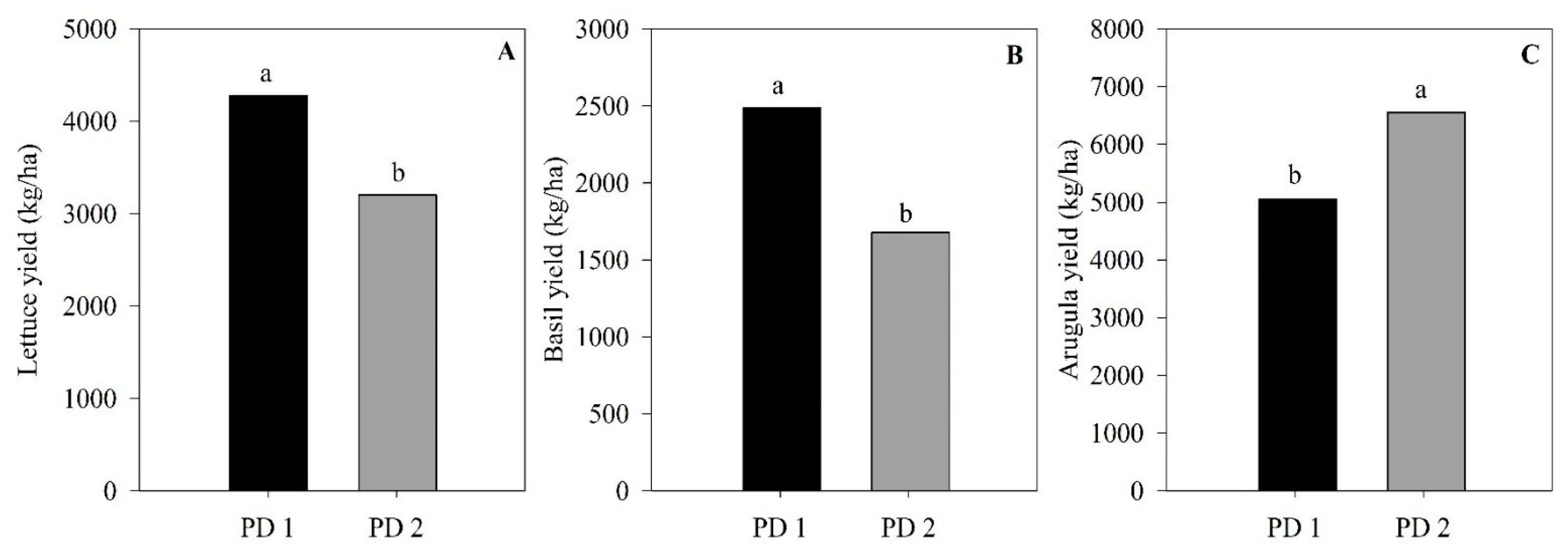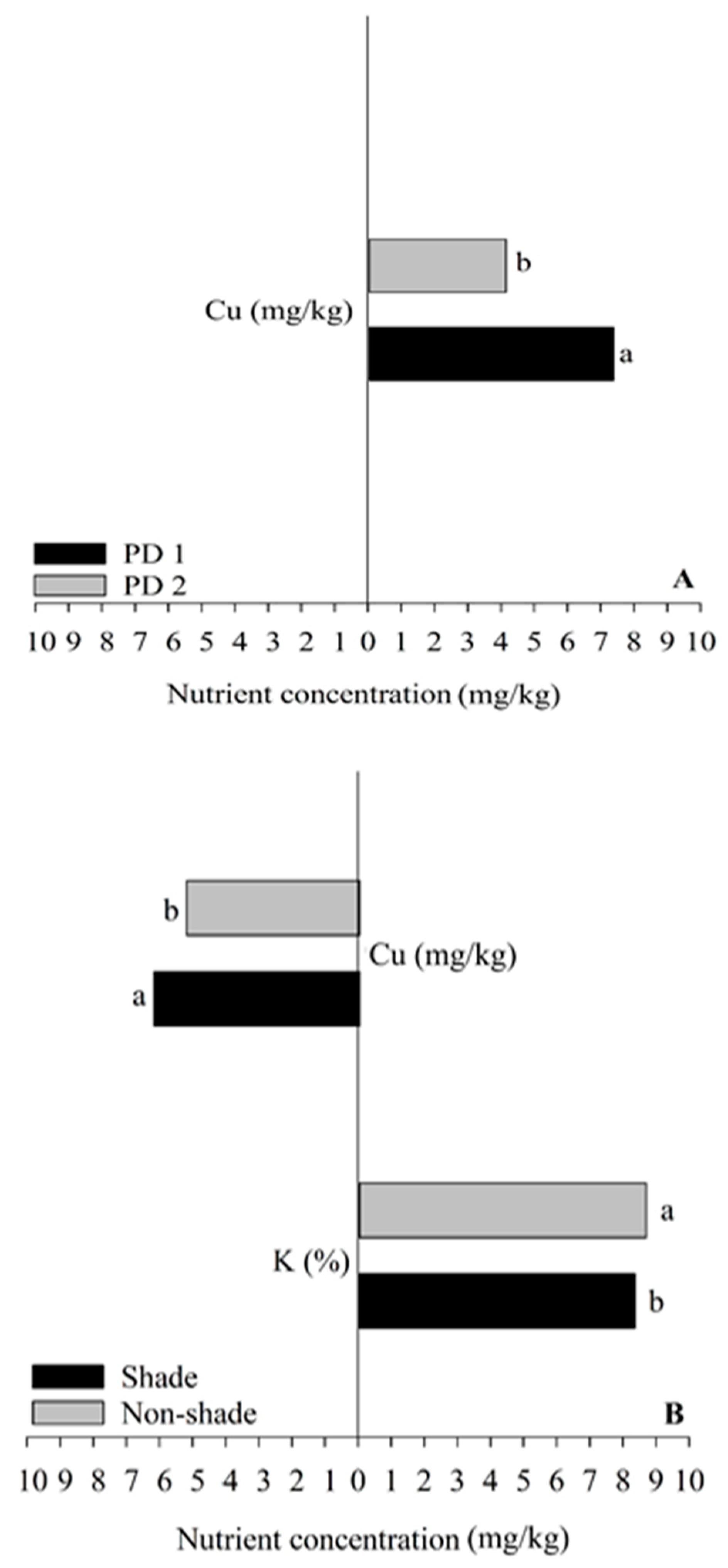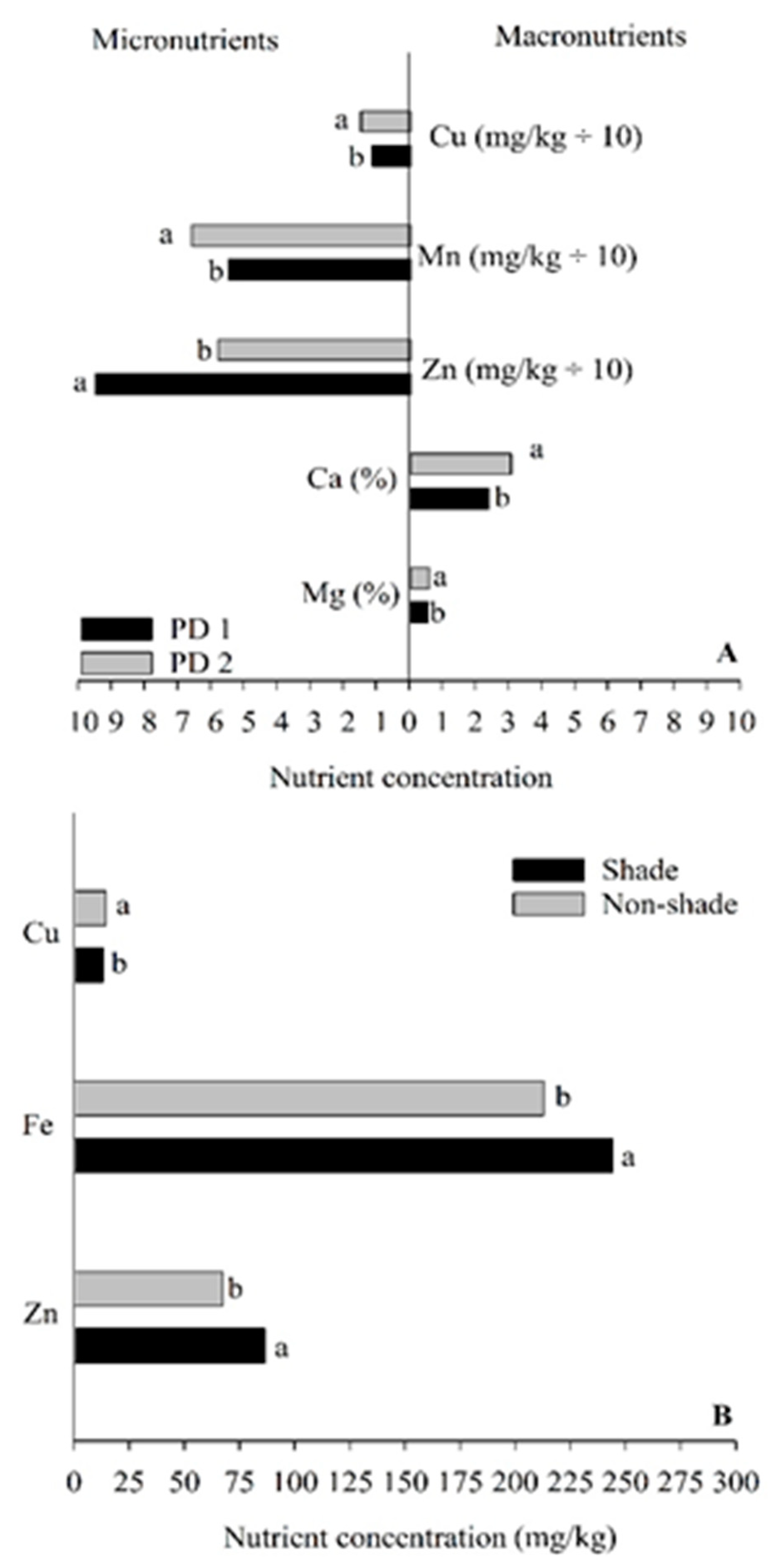Impact of Shade and Fogging on High Tunnel Production and Mineral Content of Organically Grown Lettuce, Basil, and Arugula in Georgia
Abstract
:1. Introduction
2. Materials and Methods
2.1. Experimental Location
2.2. Growing Conditions
2.3. Environmental Monitoring
2.4. Harvest and Data Collection
2.5. Statistical Analysis
3. Results
3.1. Microclimate Data
3.2. Yield
4. Discussion
5. Conclusions
Supplementary Materials
Author Contributions
Funding
Institutional Review Board Statement
Informed Consent Statement
Data Availability Statement
Conflicts of Interest
References
- Lamont, W.J. Overview of the use of high tunnels worldwide. HortTechnology 2009, 19, 25–29. [Google Scholar] [CrossRef] [Green Version]
- Carey, E.E.; Jett, L.; Lamont, W.J.; Nennich, T.T.; Orzolek, M.D.; Williams, K.A. Horticultural crop production in high tunnels in the United States: A snapshot. HortTechnology 2009, 19, 37–43. [Google Scholar] [CrossRef]
- Hochmuth, C.R.; Toro, E.D. Characterization of the Florida fresh fruit and vegetable industry using hydroponic systems or protected agriculture structures. Univ. Florida Inst. Food Agr. Sci. Bul. 2014, HS1240, 1–8. [Google Scholar]
- Byczynski, L. The Hoophouse Handbook; Growing for Market: Lawrence, KS, USA, 2003. [Google Scholar]
- Coleman, E. The Winter Harvest Manual; Four Season Farm: Harborside, ME, USA, 1998. [Google Scholar]
- Coleman, E. Four-Season Harvest; Chelsea Green Publishing: White River Junction, VT, USA, 1999. [Google Scholar]
- Wiediger, P.; Wiediger, A. Walking to Spring; Au Naturel Farm: Smiths Grove, KY, USA, 2003. [Google Scholar]
- Gu, S.; Guan, W.; Beck, J. Strawberry cultivar evaluation under high-tunnel and organic management in North Carolina. HortTechnology 2017, 27, 84–92. [Google Scholar] [CrossRef] [Green Version]
- Salame-Donoso, T.P.; Santos, B.M.; Chandler, C.K.; Sardent, S.A. Effect of high tunnels on the growth, yields, and soluble solids of strawberry cultivars in Florida. Intl. J. Fruit Sci. 2010, 10, 249–263. [Google Scholar] [CrossRef]
- O’Connell, S.; Rivard, C.L.; Peet, M.M.; Harlow, C.; Louws, F. High tunnel and fieldproduction of organic heirloom tomatoes: Yield, fruit quality, disease and microclimate. HortScience 2012, 47, 1283–1290. [Google Scholar] [CrossRef] [Green Version]
- Jayalath, T.C. The Evaluation of High Tunnel Systems for Spring Organic Lettuce Production in Georgia. Master’s Thesis, University of Georgia, Athens, GA, USA, 2016. [Google Scholar]
- Wallace, R.W.; Wszelaki, A.L.; Miles, C.A.; Cowan, J.S.; Martin, J.; Roozen, J.; Gundersen, B.; Iglis, D.A. Lettuce yield and quality when grown in high tunnel and open-field production systems under three diverse climates. HortTechnology 2012, 22, 659–668. [Google Scholar] [CrossRef]
- Jayalath, T.C.; Boyhan, G.E.; Little, E.L.; Tate, R.I.; O’Connell, S. High tunnel and field system comparison for spring organic lettuce production in Georgia. HortScience 2017, 52, 1518–1524. [Google Scholar] [CrossRef] [Green Version]
- Waycott, W.; Ryder, E.J. Adaptation of lettuce to high-temperature environments, In Adaptation of Food Crops to Temperature and Water Stress, Proceedings of the International Symposium, Asian Vegetable Research and Development Center, Taipei, Taiwan, 13–18 August 1992; Kuo, C.G., Ed.; AVRDC: Taipei, Taiwan, 1993; Publishing No. 410/93; pp. 285–295. [Google Scholar]
- Araki, Y.; Inoue, S.; Murakami, K.; Lee, J.M.; Gross, K.C.; Watada, A.E.; Lee, S.K. Effect of shading on growth and quality of summer spinach. Acta Hort. 1999, 483, 105–110. [Google Scholar] [CrossRef]
- Gao, L.; Ling, L.; Liu, J. Effects of shading-net covering on yield and quality of summer pac-choi. China Veg. 1996, 6, 11–15. [Google Scholar]
- Zhao, X.; Carey, E.E. Summer production of lettuce, and microclimate in high tunnel and open field plots in Kansas. HortTechnology 2009, 19, 113–119. [Google Scholar] [CrossRef] [Green Version]
- Arbel, A.; Yekutiali, O.; Barak, M. Performance of a fog system for cooling Greenhouses. J. Soil Sci. Agri. Eng. 1999, 72, 129–136. [Google Scholar] [CrossRef]
- Li, S.; Willits, D.H.; Yunker, C. Experimental study of a high pressure fogging system in naturally ventilated greenhouses. Act Hort. 2006, 719, 393–400. [Google Scholar] [CrossRef]
- Thompson, A.L.; Gilley, J.R.; Norman, J.M. A sprinkler water droplet evaporation and plant canopy model I. Model development. Trans. Amer. Soc. Agr. Eng. 1993, 36, 735–741. [Google Scholar] [CrossRef]
- Abdellatif, S.M.; Ibrahim, M.M.M.; El-Lithy, M.M.H. A comparative study on two different evaporative cooling systems for producing cucumber crop under hot-humid summer conditions. J. Soil Sci. Agri. Eng. Mansoura Univ. 2010, 1, 1015–1036. [Google Scholar]
- O’Connell, S.; Tate, R. Winter broccoli and cauliflower under organic high tunnels in a humid, subtropical climate. HortScience 2017, 52, 1511–1517. [Google Scholar] [CrossRef]
- Willits, D.H.; Peet, M.M. Misting External Shade Cloths: Relief from the Heat? In Georgia Commercial Flower Growers Association Newsletter; GCFGA: LaGrange, GA, USA, 1995. [Google Scholar]
- Masabni, J.; Sun, Y.; Niu, G.Y.; del Valle, P. Shade effect on growth and productivity of tomato and chili pepper. HortTechnology 2016, 26, 344–350. [Google Scholar] [CrossRef] [Green Version]
- Misra, D.; Ghosh, S. Microclimate modeling and analysis of a fog-cooled naturally Vented greenhouse. Int. J. Env. Agr. Biotech. 2017, 2, 997–1002. [Google Scholar]
- De Pinheiro Henriques, A.R.; Marcelis, L.F.M. Regulation of growth at steady-state nitrogen nutrition in lettuce (Lactuca sativa L.): Interactive effects of nitrogen and irradiance. Annals Bot. 2000, 86, 1073–1080. [Google Scholar] [CrossRef]
- Djidonou, D.; Leskovar, D.I. Seasonal changes in growth, nitrogen nutrition, and yield of hydroponic lettuce. HortScience 2019, 54, 76–85. [Google Scholar] [CrossRef] [Green Version]
- Gent, M.P. Density and duration of shade affect water and nutrient use in greenhouse tomato. J. Amer. Soc. Hort. Sci. 2008, 133, 619–627. [Google Scholar] [CrossRef] [Green Version]
- Hatfield, J.L.; Prueger, J.H. Temperature extremes: Effect on plant growth and development. Weather. Clim. Extrem. 2015, 10, 4–10. [Google Scholar] [CrossRef] [Green Version]
- Walters, K.J.; Currey, C.J. Growth and development of basil species in response to Temperature. HortScience 2019, 54, 1915–1920. [Google Scholar] [CrossRef] [Green Version]
- Coolong, T.; Law, D.M.; Snyder, J.C.; Rowell, M.A. Organic leafy greens variety trials in Kentucky: Identifying superior varieties for small-scale organic farmers. HortTechnology 2013, 23, 241–246. [Google Scholar] [CrossRef] [Green Version]
- Mills, H.A.; Jones, J.B. Plant Analysis Handbook II; Micro Macro Publishing: Athens, GA, USA, 1996. [Google Scholar]
- Marschner, H. Mineral Nutrition of Higher Plants, 2nd ed.; Academic Press: New York, NY, USA, 1995. [Google Scholar]
- Sulaiman, S.M.; Sadiq, S.Q. Influence of greenhouse shading and different nutrient management practices on alleviating heat stress, improving plant nutrients status, flowering growth and yield of tomato. Iraqi J. Agr. Sci. 2020, 51, 1001–1014. [Google Scholar]
- Sun, J.; Lu, N.; Xu, H.; Maruo, T.; Guo, S. Root zone cooling and exogenous spermidine root-pretreatment promoting Lactuca sativa L. growth and photosynthesis in the high-temperature season. Front. Plant Sci. 2016, 7, 368. [Google Scholar] [CrossRef] [PubMed] [Green Version]
- Sago, Y.; Watanabe, N.; Minami, Y. Zinc biofortification of hydroponic baby leaf lettuce grown under artificial lighting with elevated wind speed and root zone temperature. J. Agr. Meteorol. 2018, 74, 173–177. [Google Scholar] [CrossRef] [Green Version]
- Gent, M.P. Factors affecting relative growth rate of lettuce and spinach in hydroponics in a greenhouse. HortScience 2017, 52, 1742–1747. [Google Scholar] [CrossRef] [Green Version]
- Liu, X.Z.; Kang, S.Z.; Yi, H.P.; Zhang, J.H. Dry-matter partitioning, yield and leaf nutrient contents of tomato plants as influenced by shading at different growth stages. Pedosphere 2003, 13, 263–270. [Google Scholar]
- Díaz-Pérez, J.C. Bell Pepper (Capsicum annum L.) crop as affected by shade level: Microenvironment, plant growth, leaf gas exchange, and leaf mineral nutrient concentration. HortScience 2013, 48, 175–182. [Google Scholar] [CrossRef] [Green Version]
- de Groot, C.C.; Marcelis, L.F.; van den Boogaard, R.; Lambers, H. Interactive effects of nitrogen and irradiance on growth and partitioning of dry mass and nitrogen in young tomato plants. Funct. Plant Biol. 2002, 29, 1319–1328. [Google Scholar] [CrossRef] [PubMed]




| Treatment | Soil Temp. | Air Temp. | Soil VWC | RH | Leaf Wetness | PPFD | ||||||
|---|---|---|---|---|---|---|---|---|---|---|---|---|
| (°C) z | (%) | (%) | mV z | (μmol/m2 s) y | (°C) z | |||||||
| Day z | ||||||||||||
| Shade | 22.5 | b x | 24.1 | b | 25.8 | a | 65.0 | a | 467.3 | a | 415 | c |
| No Shade | 24.0 | a | 25.0 | a | 25.9 | a | 63.0 | a | 460.2 | a | 591 | b |
| Outdoor | 22.2 | b | 22.5 | c | NA w | 61.0 | a | 470.2 | a | 849 | a | |
| Fog | 23.1 | a | 24.5 | a | 28.3 | a | 64.0 | a | 485.9 | a | 564 | a |
| No Fog | 23.3 | a | 24.6 | a | 23.6 | b | 63.0 | a | 442.9 | b | 572 | a |
| Night z | ||||||||||||
| Shade | 21.0 | b | 16.0 | a | 29.2 | a | 90.4 | a | 455.7 | b | NA w | |
| No Shade | 22.3 | a | 16.3 | a | 25.8 | b | 90.0 | a | 453.5 | b | NA w | |
| Outdoor | 20.9 | b | 15.5 | a | NA | 85.0 | b | 563.1 | a | NA w | ||
| Fog | 21.7 | a | 16.1 | a | 31.8 | a | 89.7 | a | 464.3 | a | NA w | |
| No Fog | 21.6 | a | 16.1 | a | 23.6 | b | 90.8 | a | 445.0 | b | NA w | |
| Planting Date | Cover | |||
|---|---|---|---|---|
| Shade | Non-Shade | |||
| (%) | ||||
| N | ||||
| PD 1 | 4.82 | A z A y | 3.80 | b B |
| PD 2 | 6.15 | a A | 5.98 | a A |
| P | ||||
| PD 1 | 0.66 | a B | 0.38 | b B |
| PD 2 | 0.83 | a A | 0.78 | a A |
| Mg | ||||
| PD 1 | 0.35 | a A | 0.28 | b B |
| PD 2 | 0.34 | a A | 0.35 | a A |
| Ca | ||||
| PD 1 | 1.63 | a A | 1.39 | a A |
| PD 2 | 1.31 | b B | 1.41 | a A |
| Fog | Shade | Non-Shade | ||
|---|---|---|---|---|
| (%) | ||||
| Mg | ||||
| Fog | 0.34 | A z A y | 0.33 | a A |
| No Fog | 0.36 | a A | 0.28 | b B |
| Ca | ||||
| Fog | 1.41 | a A | 1.51 | a A |
| No Fog | 1.53 | a A | 1.29 | b B |
| (mg·kg−1) | ||||
| B | ||||
| Fog | 23.9 | b B | 27.0 | a A |
| No Fog | 26.6 | a A | 26.0 | a A |
| Mn | ||||
| Fog | 48.6 | b B | 67.4 | a A |
| No Fog | 63.1 | a A | 55.4 | a A |
| Planting Date | Fog | |||
|---|---|---|---|---|
| Fog | No Fog | |||
| (mg·kg−1) | ||||
| Zn | ||||
| PD 1 | 62.4 | A z A y | 40.4 | b B |
| PD 2 | 69.2 | a A | 68.8 | a A |
| Fe | ||||
| PD 1 | 277.8 | a A | 211.5 | a B |
| PD 2 | 175.2 | b A | 194.2 | a A |
| Planting Date | Cover | |||
|---|---|---|---|---|
| Shade | Non-Shade | |||
| (%) | ||||
| P | ||||
| PD 1 | 0.66 | A z B y | 0.38 | b B |
| PD 2 | 0.83 | a A | 0.78 | a A |
| K | ||||
| PD 1 | 5.98 | a A | 5.27 | a B |
| PD 2 | 4.50 | b B | 4.88 | a A |
Publisher’s Note: MDPI stays neutral with regard to jurisdictional claims in published maps and institutional affiliations. |
© 2021 by the authors. Licensee MDPI, Basel, Switzerland. This article is an open access article distributed under the terms and conditions of the Creative Commons Attribution (CC BY) license (https://creativecommons.org/licenses/by/4.0/).
Share and Cite
Laur, S.; da Silva, A.L.B.R.; Díaz-Pérez, J.C.; Coolong, T. Impact of Shade and Fogging on High Tunnel Production and Mineral Content of Organically Grown Lettuce, Basil, and Arugula in Georgia. Agriculture 2021, 11, 625. https://doi.org/10.3390/agriculture11070625
Laur S, da Silva ALBR, Díaz-Pérez JC, Coolong T. Impact of Shade and Fogging on High Tunnel Production and Mineral Content of Organically Grown Lettuce, Basil, and Arugula in Georgia. Agriculture. 2021; 11(7):625. https://doi.org/10.3390/agriculture11070625
Chicago/Turabian StyleLaur, Savanah, Andre Luiz Biscaia Ribeiro da Silva, Juan Carlos Díaz-Pérez, and Timothy Coolong. 2021. "Impact of Shade and Fogging on High Tunnel Production and Mineral Content of Organically Grown Lettuce, Basil, and Arugula in Georgia" Agriculture 11, no. 7: 625. https://doi.org/10.3390/agriculture11070625
APA StyleLaur, S., da Silva, A. L. B. R., Díaz-Pérez, J. C., & Coolong, T. (2021). Impact of Shade and Fogging on High Tunnel Production and Mineral Content of Organically Grown Lettuce, Basil, and Arugula in Georgia. Agriculture, 11(7), 625. https://doi.org/10.3390/agriculture11070625






